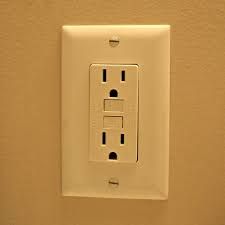Homeowners Tips:
Many homeowners may not be familiar with the term Ground Fault Circuit Interrupter (GFCI), but it’s likely that you use one every day. Ground Fault Circuit Interrupters are the outlets with the colored “Test” and “Reset” buttons. They are specifically designed to better protect people than ordinary outlets and have been used in houses since the 1970′s.
Every outlet near a source of water is required to have a GFCI outlet installed. Having a GFCI outlet installed will greatly reduce the risk of electrical shock.
How to Install GFCI Outlets
GFCI outlets reduce the danger of deadly shock from faulty plug-in cords and devices. A GFCI (ground fault circuit interrupter) is a special type of outlet that detects dangerous ground faults and immediately turns off the power to stop shocks. You can replace almost any electrical outlet with a GFCI outlet. Correctly wired GFCIs will also protect other outlets on the same circuit.
While it’s common to find GFCI outlets in bathrooms and kitchens, the electrical code also requires GFCIs in unfinished basements, garages, most outdoor receptacles and places where construction activity occurs. We’ll show you how to replace a standard duplex receptacle with a GFCI and wire it to protect other outlets.
Turn Off the Power
Note: If the existing electrical box is too small to accommodate a GFCI outlet, or if the house wiring is aluminum instead of copper, you may need to hire a qualified electrician to do this job.
Turn off the power at the circuit-breaker box. If the circuit breakers aren’t labeled, you can locate the proper switch by plugging a radio into the outlet you plan to change. Turn off the switches until the radio goes off. Then place a piece of tape over the switch to make sure no one accidentally turns it back on while you’re working on the outlet.
Remove the Cover and Separate the Wires
Remove the outlet cover plate and the screws holding the outlet in place. Test the outlet with the circuit tester to be sure the power is off. Disconnect the wires from the outlet.
Separate the wires from the box into two pairs. One set of wires will be the “line,” or power supply. The other set will be the “load,” which carries power to additional outlets on the same circuit. A GFCI outlet, properly installed, will protect all the outlets on the “load” side.
Test the Wires
Make sure the wires are completely separate from one another, then turn the power back on at the circuit-breaker box.
Use the circuit tester to determine which set of wires carries the power. Turn the power back off.
Connect the Wires and Replace the Cover
Connect the power supply wires to the terminals marked “line” and the load wires to the terminals marked “load.” Connect the white wires to the silver screws and the black wires to the brass or gold screws. The outlet may also indicate appropriate color connections.
Connect the bare ground wire to the green screw. Put the outlet back into the box, screw it into place and attach the cover plate.
Turn On the Power and Test the Outlet
Turn the power back on at the circuit-breaker box, and plug a radio into the outlet. Press the black button on the outlet. If the radio turns off, the outlet is working. Press the red button on the outlet to reset it. The radio should come back on.
Benefits Of Having A GFCI Outlet
If you look at the inside and outside of your home, you are going to notice lots of outlets. You may think that an outlet is just an outlet but that is not true. If you are looking for the outlets that are outside the house, in the garage, kitchen or bathroom you are most likely looking at ground fault circuit interrupter (GFCI) outlets. They are different than a standard outlet and are there to help protect your home and family. Call (214) 238-8353 us for your home service and repair needs.
For more related articles and info visit https://www.berkeys.com/category/electrical/
